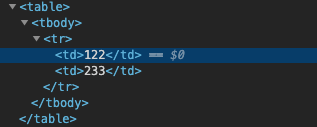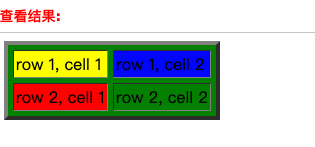前言
在CSS出现之前,table元素常常用来布局。这种做法在HTML4之后不再推荐使用。而现在有些矫枉过正,使用table展示数据都可能会被说不规范。本文将详细介绍HTML表格table
table
【默认样式】
//IE7-浏览器不支持border-spacing
table{
border-collapse: separate;
border-spacing: 2px;
border: 1px solid gray;
}
【属性】
1、border(在html5中,border只能为"1"或" ")(html5已废弃)
border="0"//没有边框
border="8"//8像素宽的边框
2、cellpadding(px/%)(html5已废弃)
规定单元边界与单元内容之间的间距
3、cellspacing(px/%)(html5已废弃)
规定单元格之间的间距
4、summary(html5已废弃)
表格内容的摘要
5、width(html5已废弃)
表格宽度
<table border="2" cellpadding="5" cellspacing="3" summary="测试表格" width="300">
<tr>
<td>row 1, cell 1</td>
<td>row 1, cell 2</td>
</tr>
<tr>
<td>row 2, cell 1</td>
<td>row 2, cell 2</td>
</tr>
</table>
6、frame(IE7-浏览器不能正常显示)(html5已废弃)
void 不显示外侧边框。
above 显示上部的外侧边框。
below 显示下部的外侧边框。
hsides 显示上部和下部的外侧边框。
vsides 显示左边和右边的外侧边框。
lhs 显示左边的外侧边框。
rhs 显示右边的外侧边框。
box 在所有四个边上显示外侧边框。
border 在所有四个边上显示外侧边框。
7、rules(IE7-浏览器不能正常显示)(html5已废弃)
none 没有线条。
groups 位于行组和列组之间的线条。
rows 位于行之间的线条。
cols 位于列之间的线条。
all 位于行和列之间的线条。
【样式】
1、border-spacing 可替代HTML属性cellspaing(IE7-不支持)
[注意]只有当border-collapse值为separate时,该样式才有效
border-spacing: x y
//x:水平间距 y:垂直间距。若只有一个值,则水平间距和垂直间距相等。注意,不可为负值。
2、empty-cells(IE7-不支持)
empty-cells: hide 不在空单元格周围绘制边框和背景,类似于hidden效果
empty-cells: show(默认) 在空单元格周围绘制边框和背景
3、CSS实际上有两种截然不同的边框模型。按布局术语来说,如果单元格相互之间是分隔的,是分隔边框模型在起作用;另一种是合并边框模型,单元格边框会相互合并。
border-collapse:separate;
[注意]在分隔边框模型中,不能为行、行组、列和列组设置边框。
border-collapse:collapse;
在合并边框模型中,表格无法设置内边距padding,且单元格边框之间也没有间距。单元格之间的边框会在单元格间的假想表格线上居中,且表格宽度只包含表格边框的一半
【边框合并的规则】
a、某个合并边框的border-style为hidden,它会优先于所有其他合并边框。这个位置上的所有边框都隐藏
b、某个合并边框的border-style为none,它的优先级最低
c、宽边框优先于窄边框
d、若宽度相同,double\solid\dashed\dotted\ridge\outset\groove\inset,优先级逐渐降低
e、若样式也相同,cell\row\row group\column\column group\table,优先级逐渐降级
4、table-layout
table-layout:auto//自动宽度布局
【自动布局的步骤】
a、对于一列中的单元格,计算最小和最大单元格宽度
b、对于各一列,计算最小和最大列宽
c、若单元格跨列,最小列宽之和要等于跨列单元格最小单元格宽度
table-layout:fixed//固定宽度布局
[注意]对于表单元格的长文本来说,使用word-wrap或word-break来强制换行,使用text-overflow实现文本溢出控制都需要设置table-layout:fixed
【固定布局的步骤】
a、width属性值不是auto的所有列元素会根据width值设置该列的宽度
b、如果一个列的宽度为auto,则根据该单元格设置此列宽度,如果跨多列,则宽度平均分配
c、如果列宽度仍为auto,则自动确定其大小,使其宽度尽可能相等
[注意]使用固定宽度布局,浏览器可以更快地计算出表格的布局
5、vertical-align
vertical-align: top;//顶端对齐
vertical-align: bottom;//底端对齐
vertical-align: middle;//中间对齐
vertical-align: baseline(默认);//基线对齐
[注意]vertical-align:sub\super\text-top\text-bottom应用到表格单元格时会被忽略
行
【<tr><th><td>】
<tr>行 table row
<th>表头 table head
<td>表格数据 table data
【默认样式】
th{
padding: 1px;
text-align: center;
font-weight: bold;
}
td{
padding: 1px;
}
【属性】
1、colspan
规定单元格可纵跨的列数
2、rowspan
规定单元格可横跨的行数
[注意]关于行的表格元素生成矩形框,这些框有内容、内边距和边框,但是没有外边距margin。表头呈现为居中的粗体文本
<table width="100%" border="1">
<tr>
<th>Month</th>
<th>Savings</th>
<th>Savings for holiday!</th>
</tr>
<tr>
<td>January</td>
<td>$100</td>
<td rowspan="2">$50</td>
</tr>
<tr>
<td>February</td>
<td>$80</td>
</tr>
</table>

列
【<col><colgroup>】<col> -> column 列
为表格中一个或多个列定义属性值
<colgroup> -> column group 列组
对表格中的列进行组合,以便对其进行格式化
【属性】
span
规定col元素应该横跨的列数
【样式】
1、visibility:collapse
该列或列组的所有单元格不显示(设置为其他值则无效)
2、border
只有当border-collapse:collapse时,才能设置border
3、background
只有当单元格及其行有透明背景时,列或列组的背景才可见
4、width
定义列或列组的最小宽度
<table border="1" style="border-collapse: collapse">
<colgroup span="2" style="width:100px; background-color: red"></colgroup>
<col style="background-color: green; width:200px; border: 3px solid blue;" >
<tr>
<td>数字</td>
<td>中文</td>
<td>英文</td>
</tr>
<tr>
<td>1</td>
<td>一</td>
<td>a</td>
</tr>
<tr>
<td>2</td>
<td>二</td>
<td>b</td>
</tr>
</table>

其他表格元素
【<thead><tbody><tfoot>】
<thead>表格页眉
<tbody>表格主体
<tfoot>表格页脚
[注意]它们的出现次序是:thead、tfoot、tbody,这样浏览器就可以在收到所有数据前呈现页脚
【<caption>表格标题】
【默认样式】
caption{
text-align: center;
}
【样式】
caption-side: top(默认)
caption-side: bottom
[注意]<caption>标签必须紧随<table>标签之后,且只能对每个表格定义一个标题
<table border="1" >
<caption style="caption-side:bottom">北京天气</caption>
<thead>
<tr>
<th>地区</th>
<th>天气</th>
</tr>
</thead>
<tfoot>
<tr>
<td>北京</td>
<td>都雾霾</td>
</tr>
</tfoot>
<tbody>
<tr>
<td>城八区</td>
<td>雾霾</td>
</tr>
<tr>
<td>郊区</td>
<td>雾霾</td>
</tr>
</tbody>
</table>

display
table{display: table;}
thead{display: table-header-group;}
tbody{display: table-row-group;}
tfoot{display: table-footer-group;}
tr{display: table-row;}
td,th{display: table-cell;}
col{display: table-column;}
colgroup{display: table-column-group;}
caption{display: table-caption;}
[注意]IE7-浏览器不支持为HTML元素设置与表格有关的display值
匿名表格对象
CSS定义了一种机制,将遗漏的组件作为匿名对象插入。详细插入规则如下:
1、如果table-cell元素的父元素不是table-row元素,则插入匿名table-row对象
2、如果table-row元素的父元素不是table、inline-table或table-row-group元素,则插入匿名table元素
3、如果table-column元素父元素不是table、inline-table或table-row-group元素,则插入匿名table元素
4、如果table-row-group、table-header-group、table-footer-group、table-column-group或table-caption的父元素不是table元素,则插入匿名table元素
5、如果table元素或inline-table元素的子元素不是table-row-group、table-header-group、table-footer-group、table-column-group或table-caption,则插入匿名table-row元素
6、如果table-row-group、table-header-group、table-footer-group元素的子元素不是table-row元素,则插入匿名table-row元素
7、如果table-row元素的子元素不是table-cell元素,则插入匿名tabel-cell元素
插入一段不合符规范的代码
<table>
<td>122</td>
<td>233</td>
</table>
看下浏览器的HTML效果:
浏览器自动补上了tr
表格层
CSS定义了6个不同的层,对应表各个方面的样式都在其各自的层上绘制。默认地,所有元素背景都是透明的,如果单元格、行、列等没有自己的背景,则table元素的背景将透明这些内部元素可见。

<table border="4" cellpadding="2" cellspacing="5" id="table" style="background-color: green;">
<colgroup>
<col id="col1" style="background-color: red;">
</colgroup>
<tbody>
<tr id="row1" style="background-color: blue;">
<td id="cell1" style="background-color: yellow;">row 1, cell 1</td>
<td>row 1, cell 2</td>
</tr>
<tr>
<td>row 2, cell 1</td>
<td>row 2, cell 2</td>
</tr>
</tbody>
</table>

边距设置
【<table>】
若处于分隔边框模型,margin和padding都可设置
若处于合并边框模型,只可设置margin
【<thead><tbody><tfoot><tr><col><colgroup>】
margin和padding都不可设置
【<td><th>】
不可设置margin,但可以设置padding
【<caption>】
margin和padding都可设置